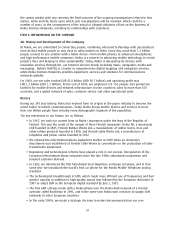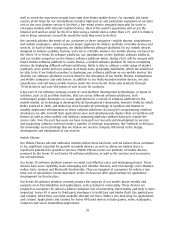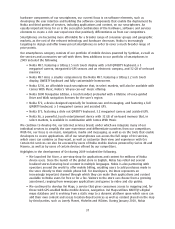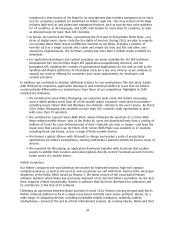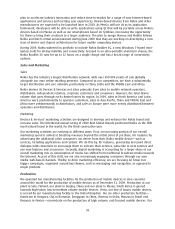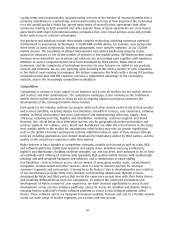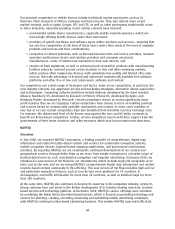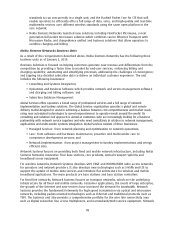Nokia 2009 Annual Report Download - page 44
Download and view the complete annual report
Please find page 44 of the 2009 Nokia annual report below. You can navigate through the pages in the report by either clicking on the pages listed below, or by using the keyword search tool below to find specific information within the annual report.We also source software, applications and content from a global network of thirdparty companies,
application developers, content providers and industryleading technology providers. For instance, we
obtain content from commercial partners in the music industry to offer an extensive catalog of digital
music through Nokia Music Store and content from travel guide publishers to expand and enhance Ovi
Maps. We have also formed a partnership with Microsoft to design a suite of productivity applications
for Nokia’s smartphones, starting with Nokia’s businessoptimized Eseries range of devices. Our
efforts to expand the opportunities for third parties to offer their services, including applications and
content, to Nokia users are part of our commitment to open innovation and collaboration as well as
to ensure we can meet and exceed the demands of consumers.
Significant developments in sourcing during 2009 included the announcement that we are partnering
with Qualcomm to develop advanced mobile devices for the Universal Mobile Telecommunications
System (UMTS) standard, initially for the North American market; and with Intel to develop a new
class of Intel Architecturebased mobile computing device and chipset architectures that will combine
the performance of powerful computers with highbandwidth mobile broadband communications and
ubiquitous Internet connectivity.
Patents and Licenses
A high level of investment by Devices & Services in research and development and rapid technological
development has meant that the role of intellectual property rights, or IPR, in our industry has always
been important. Digital convergence, multiradio solutions, alternative radio technologies, and
differing business models combined with large volumes are further increasing the complexity and
importance of IPR.
The detailed designs of our products are based primarily on our own research and development work
and design efforts, and generally comply with all relevant and applicable public standards. We seek to
safeguard our investments in technology through adequate intellectual property protection, including
patents, design registrations, trade secrets, trademark registrations and copyrights. In addition to
safeguarding our technology advantage, they protect the unique Nokia features, look and feel, and
brand.
We have built our IPR portfolio since the early 1990s, investing approximately EUR 40 billion
cumulatively in research and development, and we now own approximately 11 000 patent families.
As a leading innovator in the wireless space, we have built what we believe to be one of the
strongest and broadest patent portfolios in the industry, extending across all major cellular and
mobile communications standards, data applications, user interface features and functions and many
other areas. We receive royalties from certain handset and other vendors under our patent portfolio.
We are a world leader in the development of the wireless technologies of GSM/EDGE, 3G/WCDMA,
HSPA, OFDM, WiMAX, LTE and TDSCDMA, and we have a robust patent portfolio in all of those
technology areas, as well as for CDMA2000. We believe our standardsrelated essential patent
portfolio is one of the strongest in the industry. In GSM, we have declared over 300 GSM essential
patents with a particular stronghold in codec technologies and in mobile packet data. Our major
contribution to WCDMA development is demonstrated by over 400 essential patent declarations and in
LTE/SAE Nokia has over 150 essential patent declarations to date. Our CDMA2000 portfolio is robust
with over 150 patents declared essential.
We are a holder of numerous essential patents for various mobile communications standards. An
essential patent covers a feature or function that is incorporated into an open standard which is
deployed by manufacturers in order to comply with the standard. In accordance with the declarations
we have made and the legal obligations created under the applicable rules of various standardization
bodies, such as the European Telecommunication Standardization Institute (ETSI), we are committed
to promoting open standards, and to offering and agreeing upon license terms for our essential
patents in compliance with the IPR policies of applicable standardization bodies. We believe that a
company should be compensated for its IPR based on the fundamentals of reasonable cumulative
42


